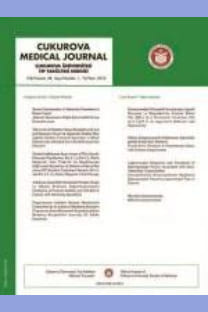Konjenital batın ön duvarı defektleri: 4 yıllık olgu serisi
Batın ön duvarı defekti, Omfalosel, Gastroşizis
Congenital anterior abdominal wall defects: 4 years case series
Anterior abdominal wall defect, omphalosel, gastroschisis,
___
- 1. Kastenberg ZJ, Dutta S. Ventral abdominal wall defects. NeoReviews. 2013;14:e402-11.
- 2. Garne E, Loane M, Dolk H, De Vigan C, Scarano G, Tucker D, et al. Prenatal diagnosis of severe structural congenital malformations in Europe. Ultrasound Obstet Gynecol. 2005;25:6–11.
- 3. Lepigeon K, Van Mieghem T, Vasseur Maurer S, Giannoni E, Baud D. Gastroschisis-what should be told to parents? Prenat Diagn. 2014;34:316-26.
- 4. Skarsgard ED. Management of gastroschisis. Curr Opin Pediatr. 2016;28:363–9.
- 5. Raitio A, Lahtinen A, Syvänen J, Kemppainen T, Löyttyniemi E, Gissler M, et al. Gastroschisis in Finland 1993 to 2014-Increasing Prevalence, High Rates of Abortion, and Survival: A Population-Based Study. Eur J Pediatr Surg. 2020;30:536-40.
- 6. D'Antonio F, Virgone C, Rizzo G, Khalil A, Baud D, Cohen-Overbeek TE et al. Prenatal risk factors and outcomes in gastroschisis: a meta-analysis. Pediatrics. 2015;136:e159–69.
- 7. Chun K, Andrews HG, White JJ. Gastroschisis in successive siblings: further evidence of an acquired etiology. J Pediatr Surg 1993;28:838-9
- 8. Al-Kaff A, MacDonald SC, Kent N, Burrows J, Skarsgard ED, Hutcheon JA. Delivery planning for pregnancies with gastroschisis: findings from a prospective national registry. Am J Obstet Gynecol. 2015;213:557e.1–8.
- 9. Gamba P, Midrio P. Abdominal wall defects: prenatal diagnosis, newborn management, and long-term outcomes. Semin Pediatr Surg. 2014;23:283–90.
- 10. Jenkins MM, Reefhuis J, Gallagher ML, Mulle JG, Hoffmann TJ, Koontz DA et al. Maternal smoking, xenobiotic metabolizing enzyme gene variants, and gastroschisis risk. Am J Med Genet. 2014;164A: 1454– 63.
- 11. Marshall J, Salemi JL, Tanner JP, Ramakrishnan R, Feldkamp ML, Marengo LK et al. Prevalence, correlates, and outcomes of Omphalocele in the United States, 1995-2005. Obstet Gynecol. 2015;126:284–93.
- 12. Benjamin B, Wilson GN. Registry analysis supports different mechanisms for gastroschisis and omphalocele within shared developmental fields. Am J Med Genet A. 2015;167A:2568-81.
- 13. Bergholz R, Boettcher M, Reinshagen K, Wenke K. Complex gastroschisis is a different entity to simple gastroschisis affecting morbidity and mortality-a systematic review and meta-analysis. J Pediatr Surg. 2014; 49:1527–32.
- 14. Lap CC, Brizot ML, Pistorius LR, Kramer WL, Teeuwen IB, Eijkemans MJ, et al. Outcome of isolated gastroschisis; an international study, systematic review and meta-analysis. Early Hum Dev. 2016;103:209–18.
- 15. Corey KM, Hornik CP, Laughon MM et al. Frequency of anomalies and hospital outcomes in infants with gastroschisis and omphalocele. Early Hum Dev. 2014;90:421-4.
- ISSN: 2602-3032
- Yayın Aralığı: 4
- Başlangıç: 1976
- Yayıncı: Çukurova Üniversitesi Tıp Fakültesi
Melih BAĞIR, Akif MİRİOĞLU, Mustafa TEKİN, Ömer BİÇER, Cenk ÖZKAN
Dismenore şiddetinin lise öğrencilerinin sosyal ve okul yaşamlarına etkisi
Cenk EKMEKCİ, Sümeyye EKMEKCİ, Cem YÜCEL, Ebru ÇAKIR
Duygu BAYRAKTAR, Leyla KHORSHİD
Testis kanserinde lenf nodu metastazını göstermede preoperatif nötrofil lenfosit oranının etkinliği
Tolga KÖŞECİ, Veysel HAKSÖYLER, Cemiler KARADENİZ, Dılşa KAYA, Okan DİLEK, Mehmet Ali SUNGUR, Berna BOZKURT DUMAN, Timuçin ÇİL
Türkiye'deki Roman toplumunun ağız diş sağlığı durumunun değerlendirilmesi
Romatoid artrit yönetiminde subkutan yüksek doz metotreksat tedavisinin etkisi
Müge AYDIN TUFAN, Emine ERSÖZLÜ BOZKIRLI, Hamide KART, Ahmet YÜCEL
Konjenital batın ön duvarı defektleri: 4 yıllık olgu serisi
Mehmet SATAR, Ahmet İbrahim KURTOĞLU, Şeref Selçuk KILIÇ, Çiğdem AKCABAY, Hacer YAPICIOĞLU, Ferda ÖZLÜ, Şerif HAMİTOĞLU, Nejat NARLI
Özgül öğrenme güçlüğü olan çocuk ve ergenlerin intihar olasılığı ve kişilik özellikleri
Dilşad YILDIZ MİNİKSAR, Büşra ÖZ
Genç inmeli hastalarda trombofili durumunun kısa dönem sonlanım ile ilişkisi
